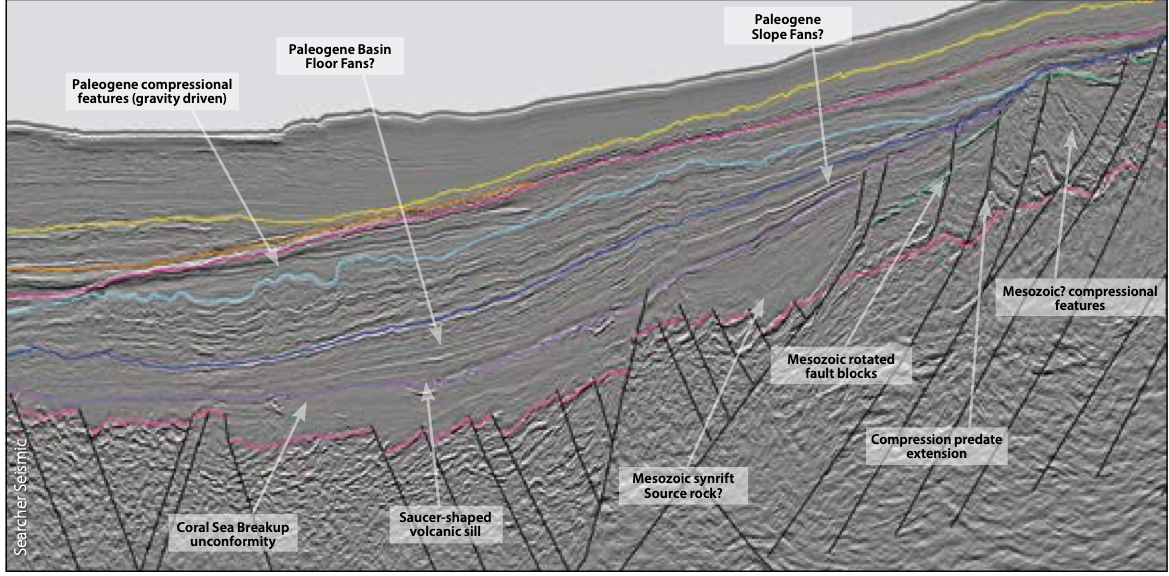
Hydrocarbon potential of the Gulf of Papua
Interpretation of new and reprocessed data reveals clear identification of promising plays.
A premier hydrocarbon region
The Gulf of Papua (GOP) has been acknowledged as a potential premier hydrocarbon region. Discoveries at Pasca, Pandora and nearshore Uramu have demonstrated the prolific charge presence analogous to other areas in south-east Asia (Jablonski et al., 2018). Exploration efforts in the deepwater GOP have been hampered by paucity of seismic data and some early models have suggested limited and geologically young sedimentation on top of the unknown age basement, most likely of oceanic origin (Struckmeyer, 1994).
Between 2015 and 2017 about 32,000 km of 2D long-offset, high-resolution, broadband seismic was acquired by Searcher Seismic, demonstrating the clearest picture yet of several depositional packages, often separated by tectonically significant unconformities. This is also supported by PSDM reprocessing of 12,972 km of the historical 2D data.
Stratigraphy of the Gulf of Papua
Several stratigraphic subdivisions have been proposed in the GOP. Whilst a Tertiary to Jurassic sequence is generally accepted, the older section is still poorly understood and limited by a lack of well information and poor legacy seismic imaging. Acquisition of new seismic data and reprocessing of historical data has led to the identification of several angular unconformities, each suggesting distinctive tectonic packages that have not been previously recognized, as described below:
- Recent to Pliocene basins defined between the present-day sea floor and Woodlark Basin break-up unconformity.
- Miocene to Paleocene basins bounded by an unconformity at the top and the Coral Sea break-up unconformity at the base, which corresponds to the C21 magnetic anomaly (5.2 Ma to 60 Ma).
- Upper Cretaceous basins defined between the Coral Sea and Tasman Sea break-up unconformities (60 Ma or 79 Ma).
- Lower Cretaceous to Upper Permian basins with the Middle Triassic and Permo-Carboniferous successions considered analogous to the Bowen and Galilee Basins located onshore Queensland in Australia.
- Lower Permian to Upper Carboniferous basins are most likely economic basement.
- Basement to Moho package allowing differentiation between continental, transitional and oceanic crust and consequently refinement of existing plate tectonic models.

Seismic markers and geophysical interpretation
With a more confident identification of a Basement and Moho marker, the interpretation of the shipborne gravity and magnetic data has allowed for a better understanding of the depth to basement and the composition of the crust, which is interpreted to be most likely of continental origin (non-oceanic; Lowe, 2016). These observations have been incorporated into a regional picture that connects geographically distant regions like onshore eastern Australia, PNG and New Zealand.
Key plays identified in Papa New Guinea
Synchronization of high quality seismic data and regional synthesis studies allow a more comprehensive play identification in the GOP. Several, often vertically stacked, plays have been identified in the GOP (Jablonski et al., 2018). These are summarised as:
- Middle Triassic to Upper Carboniferous reservoir/seal pairs analogous to the Bowen and Galilee Basins in Queensland;
- Lower Cretaceous to Upper Triassic reservoir/seal pairs – primary targets in onshore and offshore PNG exploration;
- Break-up structures of various ages;
- Miocene pinnacle structures analogous to the Pasca and Pandora gas discoveries;
- Pliocene detached basin floor fans;
- Compressional fold belt features, some up to 500 km long, not tested in deepwater.




